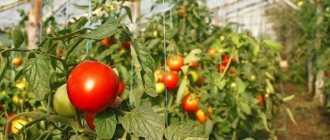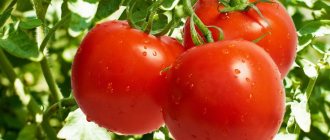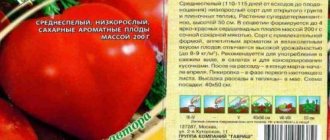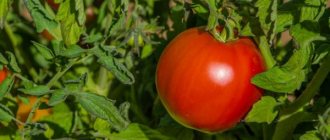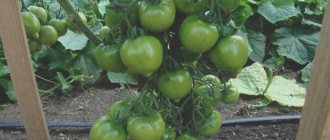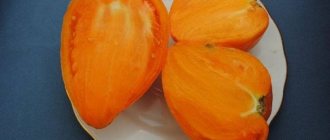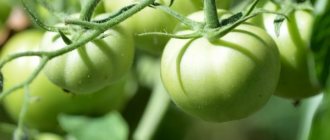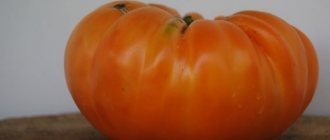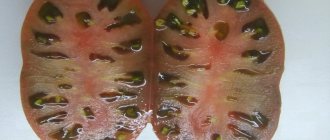The African Liana variety is a tall tomato of American origin with a thin stem and small leaves. This is one of the most delicious pink tomatoes.
| Height | Landing location | Ripening time | Fruit color | Fruit size | Origin | Fruit shape |
| Tall | Greenhouse | Mid-season | Reds | Large | Variety | Heart-shaped |
Description and characteristics of the variety
Mid-season indeterminate salad variety. Designed for greenhouses. The first harvest ripens 13-14 weeks after germination.
The average weight of the fruit is 120-180 g, the maximum is 400 g. The color is rich pink. The fruits are heart-shaped, medium and large in size, with a small number of seeds, fleshy, appetizing, very beautiful when cut. Ripe tomatoes have tender skin and a sweet, pineapple-like flavor.
Varietal characteristics
If we consider the varietal characteristics of African Liana tomatoes, it is worth noting the following points:
- the variety is mid-season, as a result of which you can begin harvesting the finished crop 100-110 days after planting the seedlings in greenhouses;
- ripe fruits can be picked in late autumn;
- the weight of a ripe fruit varies between 130-180 g, the maximum weight is 400 g;
- this variety is indeterminate;
- formation is carried out in 2-3 stems;
- It is recommended to grow exclusively indoors - in greenhouses;
- bushes can grow up to 2 m in height;
- fruits of a rich pink or crimson hue;
- excellent taste;
- attractive appearance;
- due to its versatility, it can not only be consumed fresh, but also used for canning;
- is highly resistant to many types of diseases and pests:
- a small amount of seeds.
If you provide the planting material with proper care and apply fertilizing and fertilizers on time, you can get a good harvest.
Pros and cons of the variety
Unfortunately, despite the fruitful work of breeders around the world, not a single variety has been bred so far that does not have disadvantages.
If the gist is based on photos and reviews, then the African Liana tomato has the following main advantages:
- ripe fruits have excellent taste;
- the bushes grow tall, the tomatoes are quite large;
- the harvested crop, if necessary, can be stored for a long period of time, while the appearance and taste will not be lost;
- when growing seedlings, a small number of stepsons are formed;
- the ripening period is quite long, as a result of which fresh tomatoes can be harvested until late autumn;
- Tomatoes of the African Liana variety are characterized by a high level of resistance to many types of diseases and pests.
Despite such a large list of advantages, African Liana tomatoes also have a list of some disadvantages. Among them it is worth noting:
- the yield is average for these varieties of tomatoes, but this deficiency is compensated by the excellent taste and versatility of ripe fruits;
- in most cases, African liana is recommended to be grown in a greenhouse;
- Since the bushes grow quite tall, they must be tied up, otherwise the bushes may break under the weight of the fruit.
Before you start purchasing seeds, you should first study all the advantages and disadvantages of the selected tomato variety.
Advice! To obtain high yields, it is necessary to provide high-quality care for African Liana tomatoes.
Features of cultivation and storage
To increase the yield, the ovaries are sprayed with succinic acid (1 g of the drug is dissolved in 5 liters of water). This solution can be used for spraying and watering plants, soaking seeds.
The peculiarity of the variety is that the plant first forms several flower clusters and only then it bears many fruits, which quickly gain mass.
Easy to grow variety. Tomatoes can lie on the windowsill, picked green, for about a month. After ripening, they do not wrinkle and retain excellent taste.
Rules for planting and care
To obtain a high yield, it is worth providing African Liana tomatoes with proper and high-quality care. During the growth process you will need:
- apply fertilizers;
- water the bushes in a timely manner;
- mulch the soil;
- remove weeds;
- take care of supports;
- carry out preventive measures to prevent the occurrence of diseases and pests.
Only in this way can you get a high yield with excellent taste.
Sowing seeds for seedlings
As a rule, it is recommended to sow seeds 65 days before the intended planting of seedlings in a permanent place of growth. Before sowing, it is worth disinfecting the seeds. To do this you will need:
- Prepare a weak solution with the addition of potassium permanganate - the water should turn out to be pale pink.
- Wash the seeds in this solution.
- Dry the seeds.
- Place in the refrigerator for several days to harden.
- After this, it is worth placing in a solution of succinic acid for 48 hours.
It is recommended to plant in containers filled with a mixture in a 1:1 ratio of peat and fertile soil. As soon as the first shoots have sprouted, pick them using pots with a volume of 0.5 liters or more.
Transplanting seedlings
After about 60-65 days have passed since sowing the seeds, it is necessary to begin planting the seedlings in the greenhouse. To do this, you must first dig up the soil in the greenhouse, apply fertilizer and prepare the holes.
It is important to consider that for every sq. m it is allowed to plant no more than 4 tomato bushes. In order for the root system to develop well and there are many roots, it is worth planting at a slight slope.
Since the bushes grow up to 2 m, you can take care of the support in advance and install it immediately when planting the seedlings. During the growing season, fertilize up to 2 times monthly. To do this, use a mullein solution (0.5 liters of mullein per 5 liters of water).
Tomato care
To get a good yield, you should definitely prun the bushes, which will drown out the plantings. Even if the stepsons are dry, they should still be removed, but no stumps should remain.
Watering should be systematic and regular, and the land should not be swampy or dry. It is worth applying fertilizers and fertilizing monthly, as a result of which you can achieve a high yield.
To prevent moisture from evaporating so much and weeds to grow more slowly, it is worth mulching the ground around the tomato bushes. In addition, it is important to remember about supports, since bushes can easily break under the weight of ripe fruits.
Characteristics of tomato fruits
A description of the tomato variety and fruit is very important when choosing seeds.
The Podsinskoe Miracle tomato is a large-fruited tomato; the weight of one tomato can exceed 400 grams. The shape of the fruit is plum-shaped, elongated. The skin and pulp of the tomato are pink. The pulp is juicy and tender, quite sweet and sour. Inside a tomato there are a small number of chambers and seeds. The skin is smooth, ribbed at the stalk, dense.
The Podsinskoye Miracle tomato is distinguished by its versatility in cooking. Vegetables can be eaten fresh or added to salads. It is also great for preservation. From ripe tomatoes you can prepare various sauces, tomato juices and lecho. You can pickle it whole; during the preservation process, the skin does not crack and the fruit remains intact.
When considering the taste of tomatoes, it is recommended to take into account the fact that the distinctive feature in this case is versatility and meatiness. When cut, the bright red flesh becomes visible. Tomatoes have fairly delicate skin and a sweet taste. Many gardeners note that after eating the African Liana tomato, a pineapple aftertaste remains.
Important! The weight of African Liana tomatoes can vary from 130 to 200 g; there are cases when the weight of a ripe tomato can even reach 500 g.
Growing
Due to their small growth, Liang tomatoes do not need garter. In general, this is an extremely unpretentious variety: they feel equally good both in a greenhouse and in open ground, in a warm climate (for example, in the homeland of Liana tomatoes, in Moldova, such tomatoes are sown directly in the garden). Experienced gardeners can try to grow a good bush even on their windowsill at home.
As mentioned above, you can grow Liang tomatoes by directly planting seeds in the ground, but still the best option is planting seedlings. Seedlings grow approximately 50 days after planting the seeds, so it is best to plant seedlings from late February to early spring.
From the purchased seeds, you need to select the largest ones, approximately the same size - they germinate faster. They need to be placed in a weak solution of potassium permanganate for 30 minutes, and then in a container with water for eight hours - this is necessary to disinfect the seeds.
Ideally, seeds should be planted in special soil for tomatoes to a depth of five centimeters - put several seeds in each hole and cover with soil.
When the seedlings grow, you need to keep them warm (about +24 degrees Celsius). And then, as soon as warm weather sets in, plant them directly in open ground.
This is a heat-loving plant, so you need to choose a bed where the tomatoes will receive maximum light and heat, otherwise the tomatoes may get sick.
Productivity
The yield in the greenhouse is slightly above average, in the open ground it is very low. The optimal place to place the African liana is a polycarbonate or glazed greenhouse. In open ground, about 3 kg is removed from one bush, in protected ground - about 5 kg.
As practice shows, for most gardeners, the first priority is the possible level of yield that can be obtained. It is important to consider that yield depends entirely on the conditions in which the crop will grow. Thus, when growing tomatoes in a greenhouse, the yield will be much higher than when grown in open ground. In open ground conditions, you can collect up to 3 kg of fruit from each bush, in a greenhouse - about 5 kg.
Advantages and disadvantages of the variety
The main advantage of African Liana tomatoes is their interesting, unique taste. The fruits will certainly appeal to lovers of sweetish, juicy tomatoes. Another plus is fairly good yields, which can be obtained even in the climatic conditions of Russia.
African Liana tomatoes have time to ripen on the bush
pros
- interesting, exotic taste;
- good yield;
- fruiting lasts until autumn;
- universal purpose of tomatoes;
- good immunity to diseases and pests;
- Not many stepchildren are formed.
Minuses
- tomato is heat-loving, so it can only be grown in a greenhouse;
- you need pinching (rarely) and tying (always).
Characteristics of tomato African liana
The African Liana tomato begins to bear fruit on average 3.5 months after planting: the first harvest can be harvested in the second half of June. Peak fruiting occurs in July and August. If the weather is good, you can collect fruits until the end of September. They can be picked either ripe or green (they are sent to a dark, cool place for ripening).
African liana tomato yield and fruiting
Despite the fact that the African Liana tomato is a heat-loving crop and grows well only in greenhouses, its yield is quite high: about 4-5 kg per bush for the entire season.
| Conditions | Greenhouse | Open ground |
| From 1 bush, kg | 4-5 | 2,5-3 |
| From 1 m2, kg* | 16-20 | 10-12 |
*Up to 4 African Liana tomato bushes can be planted per 1 m2.
To obtain maximum yield, bushes should be grown exclusively in a greenhouse. In addition, there are several important points to consider:
- Water regularly and abundantly.
- Apply fertilizers.
- Form a bush in 1 or 2 stems.
- Regularly remove weeds and loosen the soil.
- Try not to plant plants too often so that each bush receives the maximum amount of sunlight.
Area of application of fruits
Tomatoes are great for fresh consumption due to their unusual taste. They are also suitable for preparing various dishes:
- salads;
- sauces;
- soups;
- tomato juice;
- tomato puree.
Sweet tomatoes are good in canned vegetables (lecho, caviar). They can also be pickled or pickled for the winter (with the exception of very large fruits weighing 300-400 g or more).
Resistance to diseases and pests
African liana, like many other hybrids, has good immunity. Therefore, bushes are rarely susceptible to diseases or pests. Sometimes they suffer from improper care: for example, excessive watering can provoke the development of rot. In any case, it is recommended to treat newly transplanted bushes with a fungicide. In the future, spraying is carried out only as necessary, when signs of disease are detected.
Growing seedlings
The seedlings are fed every week with the following mixture:
- superphosphate 20 g;
- urea 5g;
- potassium chloride 5 g;
- water 10 l.
When watering, add a little potassium permanganate to the water so that the liquid turns pink. Before planting, the plants are taken out into the air during the day for gradual adaptation.
In a greenhouse, 4 plants are placed per square meter. Seedlings are planted obliquely so that as many roots as possible form on the plants. During the growing season, the bushes are fed 2 times a month with a weak infusion of mullein - 1 liter of infusion per 10 liters of water.
The growth of the African vine in height is not limited. During the season, the height in the greenhouse reaches 2 m. In heated cultivation structures, the length of the stem can reach 4 m.
Agrotechnics of cultivation
Tomato is cultivated by seedling method. 2 months before the expected date of planting in the ground, the seeds are placed in containers with moistened soil to a depth of 1 cm. Before sowing, they are pre-soaked in a solution of potassium permanganate.
Caring for seedlings involves periodic watering. For better distribution of moisture, use a sprayer. Sprouted seedlings are gradually hardened off by placing the containers in the air.
Bushes of liana-shaped tomatoes are planted at a distance of 1 m from each other, keeping a distance of 1.5 m between rows. The seedlings are laid in the soil at an angle to form additional roots. It is recommended to leave shallow grooves between the rows of tomatoes for watering.
To ensure access of air and light to the fruit cluster, liana-shaped tomatoes are tied according to the principle of a grape trellis. To do this, stakes or reinforcement are driven into the ground next to the planted bushes at intervals of 3 m and rows of wire are stretched.
This method of garter prevents the development of late blight and contributes to the improvement of the crop. When planting tomatoes in a greenhouse, you need to monitor the level of moisture in the soil and regularly ventilate the room. To get a good harvest and ensure light access to the fruits, it is recommended to regularly remove shoots.
Reviews from vegetable growers
According to reviews, vine-shaped tomatoes are popular among gardeners due to the large shape of the fruit, excellent taste, uniform ripening of the crop, and high yield per plant.
Evgenia Krylova, 45 years old, Kostroma:
“The African Liana tomato was grown in a greenhouse. The description of a mid-season variety attracted attention to tomatoes. We were pleased with the large fruits and high yield. The tomatoes are medium in size and shaped like a heart. When cut, the flesh is pink, appetizing, and sweet in taste. There are few seeds in the seed chambers. The fruits are great for canning and eating fresh.”
Anatoly Lavrov, 59 years old, Adler:
“The African Liana tomato was recommended by neighbors. The seedlings were grown from seeds and transferred to a permanent place in the garden. The bushes are tall, so we had to build trellises for tying them up. There is little foliage on the tomatoes, but for better fruiting I removed the shoots. The harvest turned out to be above average. The fruits are tasty, juicy and sweet in taste. They are pleasant to pick from the bush due to their uniform size and rich pink color. Excellent for canning and fresh consumption.”
